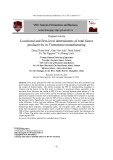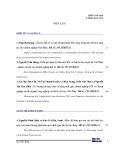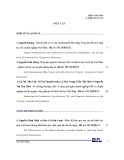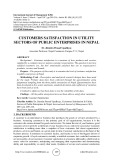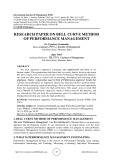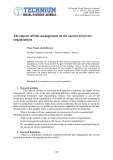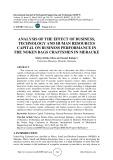
VNU Journal of Economics and Business, Vol. 4, No. 6 (2024) 1-12
1
Original Article
The direct effect of ESG reporting on firm performance:
Empirical evidence from global firms
during the early years of the green and digital twin transition
Tran Thi Hien1,*, Pham Thi Song Hanh2
1VNU University of Economics and Business
No. 144 Xuan Thuy Road, Cau Giay District, Hanoi, Vietnam
2University of Leeds
Leeds, LS2 9JT, United Kingdom
Received: November 13, 2024
Revised: November 25, 2024; Accepted: December 25, 2024
Abstract: Environmental, social, and governance (ESG) data of a firm disclosed to the public in
digital platforms in the early years signals that the firm was in their digital and green twin transition.
This study seeks to understand if the direct effect of ESG reporting on corporate social responsibility
(CFR) is positive and differs between firms in more CSR-sensitive industries and firms in less CSR-
sensitive industries that a firm is categorized into, during the early years of the green and digital twin
transition. The study uses the 2SLS IV regression method for testing the hypotheses and a global-
level dataset of 2,302 firm-year observations of 652 Fortune World’s Most Admired firms. The years
between 2005 to 2011 were chosen to study as this is in the early period when Bloomberg published
ESG data in the Bloomberg data repository. The study finds that the ESG-CFP impact is significant
and positive in the groups of industries highly sensitive to CSR but insignificant in the group of
industries which is less sensitive to CSR. The paper offers managerial implications.
Keywords: Twin transition, corporate social responsibility, CSR, ESG reporting, firm performance.
1. Introduction*
The twin transition strategy enforces the
complementary relationship between green and
digital transitions (Veugelers et al., 2023). This
socio-technical process necessitates a
paradigmatic shift to translate policy-related
uncertainties into twin transition strategies. The
________
* Corresponding author
E-mail address: hientt.hsb@vnu.edu.vn
https://doi.org/10.57110/vnu-jeb.v4i6.359
Copyright © 2024 The author(s)
Licensing: This article is published under a CC BY-NC
4.0 license.
COVID-19 crisis has led to wider recognition of
the importance of a sustainable and digital
transformation. As a result, scholars are
interested in the research question of whether
digital and green twin transitions directly help
twin firms improve their corporate financial
performance (CFP).
Copyright © 2024 The author(s)
Licensing: This article is published under a CC BY-NC
4.0 license.
VNU Journal of Economics and Business
Journal homepage: https://jeb.ueb.edu.vn

T.T. Hien, P.T.S. Hanh / VNU Journal of Economics and Business, Vol. 4, No. 6 (2024) 1-12
2
With this background, this study looks back
to the industry practice of ESG data reporting in
the early days of global firms. ESG reporting has
been commonly used to show evidence of the
corporate social responsibility (CSR)
performance of firms in the industry. Research
shows that ESG disclosure has a significantly
favorable effect on CFP (Chen & Xie, 2022).
However, the ESG reporting - firm performance
link may be subject to the industry context. In
this light, our study seeks to understand if a
firm's economic outcome of ESG reporting
varies following the sensitiveness of the industry
toward CSR in an economic uncertainty period.
However, the effect of ESG reporting on CFP is
unclearly understood and varies among
industries as shown in various reviews of the
studies on ESG and firm performance (i.e., Li et
al., 2024).
This study seeks to understand if the
economic outcome of ESG reporting varies
following the sensitiveness of the industry
toward CSR. Using the global-level data of 652
Fortune World’s Most Admired (FWMA) firms,
this study finds empirical evidence of the
significant and positive effect of CSR on CFP,
but the results do not hold for every industry. The
effect is sensitive to the industry practice in ESG
reporting. The impact is significant and positive
in the groups of industries highly sensitive to
CSR and insignificant in the group of industries
less sensitive to CSR. That is, the impact is
clearer for the industries prone to CSR scandals.
This study has two main contributions to the
literature. First, this study looks back to the
initial period of the green and digital twin
transition of global firms to find evidence of the
effect of ESG reporting on CFP. The study
points to an intriguing concept of “CSR
sensitive” vs “CSR non-sensitive” industries
which future research could develop further
when examining CSR practices. This study
sheds more light on the CSR-firm performance
relationship by showing that the link is subject to
the sensitivity to CSR of industries. This study is
among the first to explain that the direct effect of
ESG reporting on firm performance is subject to
the industry's sensitivity to CSR. Second, the
direct impact of E on CFP is not clear but that of
ESG is significantly positive and robust. The
direct effect of ESG reporting on firm
performance is likely significant and positive
only in CSR-sensitive industries, and it becomes
insignificant in CSR-non-sensitive industries
evidenced in the economic recession period.
This explanation is justified by analyzing a
global-level dataset of the firms pioneering in
twinning digital and green technologies.
2. Literature review and hypotheses
2.1. ESG reporting and CFP
ESG reporting can be defined as the
information a company discloses about its
governance, social, and environmental
performance in all forms of corporate reporting
to stakeholders. Attention to stakeholder
concerns and expectations may help a firm avoid
decisions that might prompt stakeholders to
undercut or thwart corporate objectives (Wang et
al., 2016). As firms’ socially responsible
behaviours influence a wide range of stakeholder
groups, ESG reporting has typically been seen as
discretionary in promoting social interests and
addressing stakeholder expectations (Zhu et al.,
2014). Findings from both marketplace polls and
academic research suggest that key stakeholders
such as consumers, employees, and investors are
more likely to take actions to reward good corporate
citizens and punish bad ones (Du et al., 2010).
However, for stakeholders to realize that a
firm is a good corporate citizen, the firm needs
to communicate with the public about its CSR
activities. Without communication, no matter
how many CSR initiatives companies develop,
the impact of CSR on stakeholder perceptions
would be null (Du et al., 2010). Indeed, many
scholars applied legitimacy theory to examine
the outcomes of ESG reporting as documented in
Pérez (2015), a review paper of the literature on
the link between corporate reputation and ESG
reporting. According to Suchman (1995, p. 574):
“Legitimacy is a generalized perception or
assumption that the actions of an entity are
desirable or appropriate within some socially
constructed system of norms, values, beliefs, and
definitions.” When a firm provides information
about its CSR activities, the firm appears to be
legitimate in the eyes of the public and their
stakeholders, who according to stakeholder
theory have the power to influence the
achievement of economic outcomes of the firm.
Studies on ethical consumerism suggest
consumers increasingly care about the ethical
components of products and business processes
(Auger et al., 2003). A firm’s CSR effort may

T.T. Hien, P.T.S. Hanh / VNU Journal of Economics and Business, Vol. 4, No. 6 (2024) 1-12
3
serve as an added advantage for the firm and a
pre-condition of the firm’s benefits, such as a
positive response (Sen & Bhattacharya, 2001)
and purchase intention (Lee & Shin, 2010).
Customers tend to be more satisfied with socially
responsible firms (Lee & Heo, 2009). Satisfied
customers may result in loyalty (Bolton & Drew,
1991), a willingness to pay a higher price
(Homburg et al., 2005), and positive word-of-
mouth comments (Szymanski & Henard, 2001).
By reporting the information about CSR
activities, a company can persuade customers
that they are socially responsible. Consequently,
ESG reporting may foster customers’ loyalty and
turn consumers into company/brand
ambassadors and champions who engage in
advocacy behaviours (Du et al., 2010). As a
result, firms may reap a price premium or
increase of their market share.
The business rewards of ESG reporting are
not confined to the consumer domain but also to
other stakeholders, such as employees, investors,
and suppliers. The business returns to ESG
reporting are contingent on stakeholders’
awareness of a firm’s CSR activities
(Du et al., 2010). CSR communication may help
recruit, motivate, and retain good employees.
Dutton et al. (1994) demonstrate that employees
show greater commitment to a firm that has a
good public image in supplying human capital.
Moreover, such firms are often perceived as
attractive employers by job seekers (Backhaus et
al., 2002). Therefore, a firm that releases more
CSR information has a higher chance to recruit
productive and talented staff, which results in
better performance. De Roeck et al.’s (2016)
findings from a longitudinal study suggest the
long-term impact of employees’ perceptions of
CSR on their willingness to feel a stronger sense
of belonging to their organizations.
Employee engagement is the key to
improving CFP. Firms reporting CSR
information are more likely to be seen as good
corporate citizens, to be able to attract more
capital from investors as well as receive more
favourable terms from creditors. This is because
many individuals likely wish to align their
investment with their moral aims (Sprinkle &
Maines, 2010). In brief, ESG reporting is likely
to stimulate more employees’ commitment,
attracting more investors and more customers
who eventually contribute to good CFP. As such,
we propose:
H1: A firm’s ESG reporting positively affects
CFP.
2.2. CSR-sensitive vs non-sensitive industries
It is worth recalling that empirical evidence
about the direct link between ESG reporting and
economic performance is inconsistent. Some
studies report positive, some find negative and
others record no correlation (see the reviews by
Abernathy et al., 2017; Brooks & Oikonomou,
2018; Orlitzky et al., 2003; Pérez, 2015; Wang
et al., 2016). We argue that the inconsistent
findings in the previous studies may arise from
the industry context.
Due to differences in the production process,
different industries are likely to have different
operation practices, leading to potential gaps in
the impacts they exert on the natural
environment and human and animal welfare. In
particular, some industries may cause more harm
to the environment and society than others. For
example, the tobacco industry is seen as harmful
to human health. The automobile, chemical,
mining, oil, and gas industries are considered to
create a negative impact on the environment
(Gopal & Thakkar, 2016; Ranängen & Lindman,
2018; Coraiola & Derry, 2019; Chowdhury et
al., 2019). Meanwhile, other industries such as
banking and finance, broadcasting, and
consulting services may be seen as less harmful
to the environment and human and animal life.
Therefore, the public may hold a different level
of expectation and evaluation of CSR practices
by firms in the industry. Accordingly, CSR
practices may differ among industries. The
industries potentially more harmful to the natural
environment or human and animal life are more
sensitive to the public's reaction to CSR issues
than the industries that are seen as less harmful
to the environment or human and animal life. We
refer to the former as CSR-sensitive industries
and the latter as CSR non-sensitive industries.
Firms in CSR-sensitive industries are likely
to attract attention from the public about their
CSR performance. Therefore, in those
industries, the firms that report more CSR
information would meet the public's expectation
of the firm and consequently obtain favour from
the stakeholders who subsequently reward the
firms for being good corporate citizens. The
studies of firms in automobiles (Gopal &
Thakkar, 2016), tobacco (Coraiola & Derry,
2019), and oil and gas, (Chowdhury et al., 2019)
suggest a significant and positive effect of ESG

T.T. Hien, P.T.S. Hanh / VNU Journal of Economics and Business, Vol. 4, No. 6 (2024) 1-12
4
reporting on CFP. Meanwhile, firms in CSR
non-sensitive industries are less likely to attract
attention from the public about their CSR
performance than the CSR-sensitive industries.
Consequently, the latter’s effort in CSR
performance and reporting may not get rewarded
as much as ESG reporting in the CSR-sensitive
industries. Taken together, we propose that:
H2: The positive effect of ESG reporting on
CFP in CSR-sensitive industries is more
pronounced than that in CSR-non-sensitive
industries.
3. Research method
3.1. Estimation model
Performancei,t = β0 + β1CSRreportingi,t-1 +
β2Industryaveragei,t-1 + β3Insitutioni,t-1 +
β4Salesi,t-1 + β5Asseti,t-1 + β6CEOdualityi,t-1 +
β7Bindependencei,t-1 + β8Leverage i,t-1 + β9Crisis
+ β10Countrydummyit + β11Yeardummyit + εit (1)
CFP (Performance) was alternatively
measured by Tobin’s Q, ROA, and ROE. These
indicators are the most common indicators used
to reflect a firm’s performance in many prior
studies such as Rashid (2015).
ESG reporting (ESGreporting) is proxied by
ESG disclosure scores calculated by Bloomberg
(Lai et al., 2016) based on the amount of
environmental, social, and governance (ESG)
information that a company disclosed. The
scores span from 0.1 for firms that revealed a
minimum amount of data to 100 for those that
communicated every data point.
Control variables
Industry performance (Industryaverage):
The industry of a firm is an essential part of the
business environment which frames
organizational competition strategies and
practices. Specifically, the heterogeneity in
industry structures is likely to contribute to
variations in the CFP in different industries.
Thus, we controlled the industry to capture the
industry effect as conventionally done in
previous studies on CFP, such as Datta et al.
(2005). Following Le and O’Brien (2010), the
industry effect was captured through the
industry’s average performance measured by
median CFP for each industry in a year.
Institution: Institutions are the constraints
that structure political, economic, and social
interactions (Hodgson, 2006). Thus, we control
for the effect of the institution on the firm's
reputation and performance.
Sales: Sale performance is a crucial part of
determining the CFP of the firm (Davis &
Albright, 2004).
Asset: Firm size has long been cited as a
potential determinant of CFP. We captured firm
size with total assets as done by previous
research such as Rashid (2015).
CEO duality (CEOduality): When the CEO
is also a board chair of a firm, this may help
establish strong, unambiguous leadership, but it
may also promote CEO entrenchment (Peng,
2004). Given the unresolved relationship
between CEO duality and CFP (Boyd, 1990), we
include CEO duality as a control variable.
Board independence (Bindependence) has
long been posited as a potential determinant of
CFP because it helps to address the agency
problem in a public corporation where
ownership and management are separated. We
measured board independence by the proportion
of independent directors on the board (Rashid,
2015).
Financial leverage (Leverage): Debt finance
provides an alternative and complementary
control mechanism to managerial equity
ownership and family ownership for reducing
agency costs of a firm (Seetharaman et al., 2001)
and thus potentially influencing CFP. Financial
leverage was popularly controlled in previous
studies of the link between corporate governance
and CFP (Henry, 2010).
Crisis (Crisis): As our dataset spans the
global financial crisis, 2007-2008, we added the
shock to the model by using a dummy variable,
Crisis, for control. Crisis takes the value equal to
1 for the 2007-2008 observations and 0 for other
year observations.
Country effect (Countrydummy): Home
country factors may influence CFP due to the
heterogeneity in demand and capital costs
among countries. To capture the time effect, we
also control for the year effect (Yeardummy) in
the model.
CSR sensitive vs non-sensitive industries
Colombo et al. (2019) argue that CSR can be
an area under which issues traditionally
negotiated by companies and unions (e.g. health
and safety issues) and issues of interest of both
parties (e.g. environmental issues) might be
framed. CSR can be a platform for current and
new negotiations among social partners, which
might provide them with a “'humus for

T.T. Hien, P.T.S. Hanh / VNU Journal of Economics and Business, Vol. 4, No. 6 (2024) 1-12
5
cooperation”' (Colombo et al., 2019).
Accordingly, the average level of ESG reporting
in one industry can reflect the level of sensitivity
of the public to the industry’s CSR practices.
Therefore, we divide the samples into CSR-
sensitive vs non-sensitive industries by the cut-
off between the median value of ESG reporting.
3.2. Data
We selected a sample of the firms from the
Fortune World’s Most Admired (FWMA) rating
list. The 2005-2011 data for the home country
and industry of a firm, and data for financial
soundness reputation rating of a firm were
manually collected from the FWMA website.
The years 2005-2011 is the early period in which
Bloomberg published ESG reporting data in the
Bloomberg data repository.
ROA and ROE, market value and total assets
for calculation of Tobin’s Q, and the aggregated
environmental, social, and governance
disclosure score, percentage of independent
board members, debt-to-equity ratio, and total
sales from 2005 to 2011 were collected from
Bloomberg. After that, we checked CEO duality
in company annual reports and collected data for
the institution score of each country in the
dataset from the Global Competitiveness
Reports published by the World Economic
Forum.
After deleting the observations that have the
missing data for the variables of the model, there
are 2,302 firm-year observations from 652
companies left in the final dataset, including 30
industries in 29 countries.
4. Results and interpretation
4.1. Descriptive statistics and correlation matrix
Regarding the total assets of the firms, the
mean average total asset is 78,229.58 million
USD. The mean average number of employees
of a firm is 66.805 staff while ROA and ROE are
respectively 5.30 and 15.37 percent on the mean
average. Tobin’s Q ranges from -0.05 to 9.40 and
has a mean of 1.31. At first glance, there is no
significant bivariate correlation between
ESGreporting and CFP.
Figure 1 shows the mean ESG reporting
level of firms in each of the 30 industries. The
top 10 industries reporting CSR include
Chemicals, Automobile, Tobacco, Beverages &
Brewery, Telecom, Electronics, Metal and
Mining, Oil and Gas, Machinery and equipment,
and Engineering/R&D Services. The pattern that
emerged from the bar chart demonstrates that the
top ESG reporting firms are in heavy industries
and the Tobacco and Beverages & Breweries,
which are all related to environmental harm
and/or controversial industries (Leung & Snell,
2017). The 10 industries with the lowest ESG
reporting level include
Distribution/Wholesale/Commerce, Agriculture,
Consulting Services, Broadcasting Audio-Video
Publishing, Human Resources, Real estate,
Hotel, Retail, and Others. Among these,
Distribution/Wholesale/Commerce reports the
least information on CSR; this is because,
possibly, this sector has the least direct contact
with consumers.
The mean VIFs are 1.45 [1.46] [1.44] when
ROA, ROE, and Tobin's Q are alternatively the
dependent variables, all well below the rule-of-
thumb value of 4. This demonstrates that the
assumption of no perfect multicollinearity is not
seriously violated.
4.2. Endogeneity
The IV 2SLS regression method was used to
address the potential problem (Wooldridge,
2013). We employ the sound financial reputation
of a firm (Soundfinance) as the instrument
variable of ESGreporting. Firms that are
transparent in disclosing CSR information are
usually transparent in financial health, hence
have a good reputation in financial soundness.
Soundfinance is correlated with ESGreporting
but uncorrelated with the error term.
To check if ESGreporting is exogenous, we
conducted the Durbin (score) chi-sq test and Wu-
Hausman F test of endogeneity of ESGreporting.
The large P-values obtained from these tests
show that the hypothesis of an exogenous
regressor cannot be rejected (p > 0.1). The first-
stage regression summary statistics of the Wald
test show that p < 0.05, indicating that the
instrument variable is not weak.
As seen in Table 2, there is statistical
evidence that ESG reporting has a positive effect
on firm CFP, ROA, ROE, and Tobin’s Q
respectively in the whole sample (β = 0.123, P
value = 0.000 in Model 1; β = 0.364, P value =

